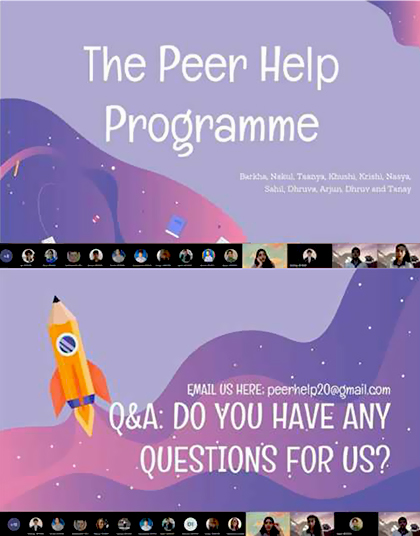Peerhelp
The inspiration for Peer Help MAD Project came from our previous experience of informally helping juniors with academics. Encouraged by the positive feedback we had been receiving, we decided to create an official platform in school that enabled peer-tutoring.
Although we were confident that this project would be effective, we had a lot of work ahead of us including recruiting other mentors, proposing the idea to Heads of school, and finding students willing to take part in such a project.
We were probably most nervous about presenting the idea to the Heads as we were unsure about how they might react to the idea of setting up an internal academic assistance system. However, to our surprise, they were very keen on implementing it and promptly scheduled the sessions for us.
One of the trickiest aspects of this was pitching the idea to both teachers and students. While convincing the authorities of its benefits, we had to find evidence supporting the need for such a program and we went to the extent of conducting surveys to ascertain whether students would find this helpful. On the other hand, while asking students to enroll, we had to convince them that they would enjoy it. Since we were asking them to go out of their way and invest time in this program, we had to be as engaging as possible to meet our end of the deal. As a result, our structure had to be both effective and enjoyable. We also made sure that this was a bilateral exchange, where we learned as much from teaching as they did from learning.
Despite the obstacles in our journey such as organizing sessions on Microsoft Teams, asking for enrolments, and communicating and logistics, we learned how to tackle such problems with tenacity, patience, and adaptability.

The experience was highly fulfilling as we got to interact with many students types: from those who were eager to go beyond the syllabus for their love of learning to those who just wanted the skills to cope. We experienced not only the satisfaction of clearing academic concepts but also gaining students’ confidence and faith.
We are proud to have not just made a short-term impact, but to have established a long-term process that connects those willing to teach their peers and those who can benefit from it. We aim to bridge any disconnect across grades, ensuring that students can reach out to their own seniors for help, and never feel that they are without sufficient guidance. The DAIS student body is supportive and intellectually passionate, we merely created a platform to catalyse this.

